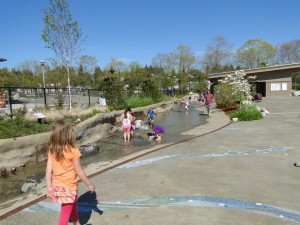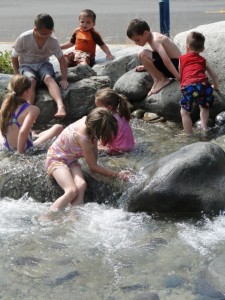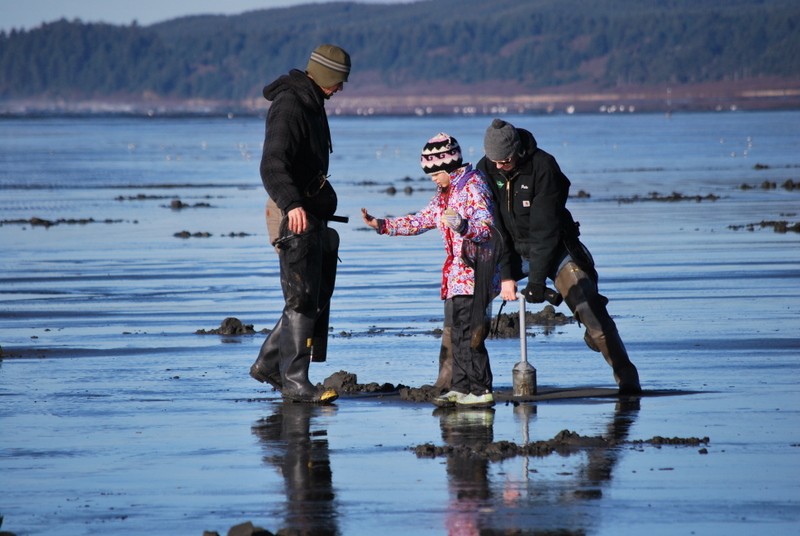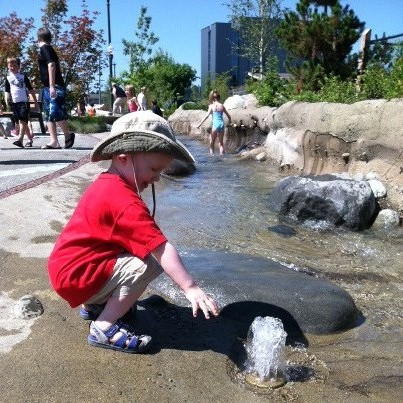Submitted by Port of Olympia

The East Bay Public Plaza is one of only 30 projects nation-wide to receive certification under the Sustainable Sites Initiative™ (SITES™) Rating System for sustainable landscape design. SITES holds high standards for certification; out of 150 projects that recently applied for certification, only four projects were certified – East Bay Public Plaza being one of them.
The East Bay Public Plaza, located along Olympia Avenue between Marine Drive and Jefferson Street, is owned and operated by the LOTT Clean Water Alliance. It was developed as a joint project of the East Bay partners – the City of Olympia, Port of Olympia, Hands On Children’s Museum, and LOTT. The plaza highlights the partners’ shared educational focus on the importance of water and sustainability.
The Plaza was awarded a one-star rating by the SITES program, which is similar to the LEED certification program, but focuses on outdoor spaces rather than buildings. A few of the sustainable design features include:
- Interactive water feature fed by Class A Reclaimed Water
- Use of reclaimed water for irrigation and toilet flushing
- Vegetated green roof on restroom building
- Energy-efficient LED lighting
- Benches made of recycled content
- Native and drought-tolerant plants
- Redevelopment of a brownfield
The most striking feature of the plaza is the stream-like water feature, which is truly unique. It is the first and only recreational water feature in the state that uses reclaimed water. LOTT produces high-quality Class A reclaimed water from the water we use and discard every day. It is the highest quality of reclaimed water in the state, meeting stringent water quality standards and permit requirements from the state Departments of Ecology and Health.
 “We are pleased to be among those taking a lead in applying the SITES program rating system to enhance the environmental, social and economic aspects of our projects,” said Mike Strub, Executive Director for the LOTT Clean Water Alliance. “This certification is evidence of our commitment to the environment and to our communities.”
“We are pleased to be among those taking a lead in applying the SITES program rating system to enhance the environmental, social and economic aspects of our projects,” said Mike Strub, Executive Director for the LOTT Clean Water Alliance. “This certification is evidence of our commitment to the environment and to our communities.”
East Bay Public Plaza was designed by Robert W. Droll, Landscape Architects, PS, a landscape architectural firm in Lacey, WA. It was constructed by Berschauer Phillips/FORMA Construction Company in Tumwater, WA. The plaza was completed and opened to the public in August 2012. Since then, it has become a popular place for picnicking and family fun during warm weather and a popular destination throughout the year.
The SITES program is an interdisciplinary effort led by the American Society of Landscape Architects, the Lady Bird Johnson Wildflower Center at The University of Texas at Austin, and the United States Botanic Garden to create a voluntary, national rating system and guidelines for sustainable landscapes of all types, with or without buildings. Certification is based on The Sustainable Sites Initiative™: Guidelines and Performance Benchmarks 2009.
Since 2009, the SITES program, in conjunction with a diverse group of stakeholder organizations, has worked to transform land development and management practices with this first national rating system for sustainable landscapes. The guidelines apply to any type of designed landscape, with or without buildings, including shopping malls, streetscapes, subdivisions, corporate and academic campuses, transportation corridors, parks and recreation areas, and single family homes.
The U.S. Green Building Council, a stakeholder in the Sustainable Sites Initiative program, anticipates incorporating the SITES guidelines and performance benchmarks into future iterations of its LEED® Green Building Rating System™. While LEED minimizes the carbon footprint, SITES demonstrates how a landscape can actually sequester carbon and regenerate living systems. Working together these initiatives will further revolutionize sustainable design.





















































